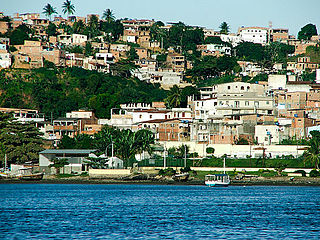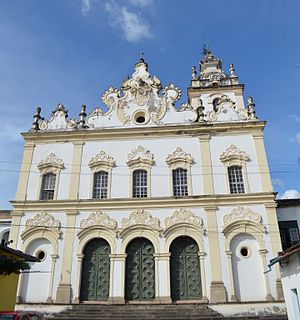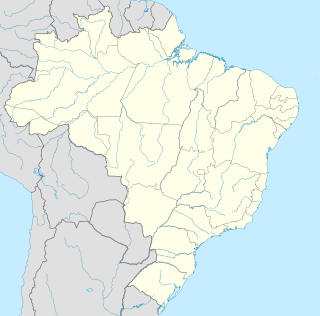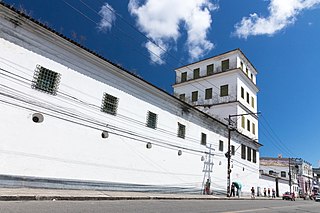
Pituba is a large upper class neighborhood located in the southeastern zone of Salvador, Bahia. Its main routes, the Avenues Manoel Dias da Silva and Paul VI. Pituba's name is indigenous origin and means "breath, breath, sea".

Pituba is a large upper class neighborhood located in the southeastern zone of Salvador, Bahia. Its main routes, the Avenues Manoel Dias da Silva and Paul VI. Pituba's name is indigenous origin and means "breath, breath, sea".
At the beginning of the twentieth century, Joventino Pereira da Silva, along with his brother-in-law Manoel Dias da Silva, bought the farm Pituba, and together they sketched out the plan City Light. Joventino, which was mining, has brought with it the idea to deploy in a Pituba equal to the modern structure of Belo Horizonte, with blocks divided strategically, wide streets and many beautiful spaces for housing. The project of blending was published in 1919, with a report signed by the civil engineer Teodoro Sampaio, and approved by the City of Salvador in 1932. The rummage of the land established the opening of 10 routes parallel to the shoreline, some of which were denominated boulevards, and 15 cross perpendicular to the first. It was established in a document of 1915 that the mainstream of the streets, then known as Estrada's Pituba, would be called Avenida Manoel Dias da Silva, formalized by the Municipal Law No 1664 of December 2, 1964. After the creation of Avenida Manoel Dias da Silva and all other transverse and longitudinal, the neighborhood did not stop growing. And there will be 87 years. Step by step, the Pituba was born like this: after the work of Joventino and Manoel Dias (above), came the construction of the Avenue Otávio Mangabeira, on the edge, which carried the name of the then governor. Only in the 1960s, Nelson Oliveira, mayor of Salvador, covered the asphalt streets of Pituba. Work just completed in the following decade.
Precisely at the turn of the decade from 60 to 70 was that there was verticalization and the process of expansion, with the construction of the Avenue ACM and large real estate ventures, such as Our Lady of Light Park and Park Condominium Julio Caesar. Then came the Park City, the division of Trees Road, the Shopping Iguatemi (1975) which was the first shopping mall to be built in northeastern Brazil, the Mall Itaigara (1977), among many others. In the 80s and 90s Avenida Tancredo Neves consolidated itself as the new economic center of the city, na Avenida Paulista "Bahia. In 1999, the Avenida Manoel Days went through a reform, having extended its sidewalks and street lighting, giving it a more cosmopolitan air and becoming one of the most valued neighborhoods of the capital Bahia, being recognized for their services and various shops.



It has the main high school in the city, such as the Military College of Salvador, the Anchieta College, the College Gregor Mendel, the Versailles College and the College Módulo. In addition, the headquarters of the Post Office is located in this region. There is also a wide variety of bars and banks. Since the 1970s has shown (similarly to the neighboring districts of Itaigara and Iguatemi) strong population growth through enterprise development.
The neighborhood of Pituba is in strong trade, with businesses of all types and large shopping malls. Corporate buildings, hotels, banks, rental, restaurants, lan houses, bookstores, boutiques of the most diverse labels, decoration of shops, Course of vestibular – a number of ventures that give the region the status of the neighborhood recognized with the widest range of shops and services in the city. Not counting that the city's main shopping malls there are.
The Pituba, in addition to the various plazas and the City Park, has a myriad range of options for leisure and entertainment: bars, restaurants, theaters, galleries, nightclubs, among others. The fun happens at any time and therefore the neighborhood is always busy. Moreover, Pituba has great access roads to those who come from other parts of the city: Otávio Mangabeira Avenue, Manoel Dias da Silva Avenue, ACM Avenue, Paulo VI Avenue, and Avenue Juraci Magalhaes Magalhaes Neto.
Today the neighborhood account with 25 boulevards (besides the great avenues) and more than 150 streets. The estimated population is around 250,000 people.
Locations that are part of the Administrative Region VIII Pituba:

Salvador, also known as São Salvador da Bahia de Todos os Santos, is the capital of the Brazilian state of Bahia. With 2.9 million people (2020), it is the largest city proper in the Northeast Region and the 4th largest city proper in the country, after São Paulo, Rio de Janeiro and Brasília.

Cachoeira is an inland municipality of Bahia, Brazil, on the Paraguaçu River. The town exports sugar, cotton, and tobacco and is a thriving commercial and industrial centre.

Avenida Brigadeiro Faria Lima, most commonly known as just Faria Lima, is an important avenue in the city of São Paulo, Brazil. It spans the upscale Pinheiros, Jardim Paulistano, Itaim Bibi and Vila Olímpia neighborhoods. It is also an important commercial and financial center that rivals the downtown and Paulista Avenue areas. The avenue has recently started to be perceived as some sort of "Brazilian Wall Street" due to the many financial institutions headquartered there or on adjacent streets. Examples include BTG Pactual, Itaú BBA, Bradesco BBI, Goldman Sachs, Credit Suisse, Morgan Stanley, Bank of America Merrill Lynch, JPMorgan Chase, UBS and many others.
The Archdiocese of Luanda is the oldest Roman Catholic (arch)bishopric in Angola.

Barra is a neighborhood located in the south zone of the city of Salvador, Bahia, Brazil. Barra is one of the most traditional neighborhoods of the city, and is also one of the most popular neighborhoods for tourists, with many attractions, like Farol da Barra Lighthouse, Morro do Cristo Hill, Farol da Barra Beach, and Porto da Barra Beach.

Itaigara is a neighbourhood located in the southeastern zone of Salvador, Bahia. Modern and bold lies in a region "noble" of the capital Bahia, inhabited mainly by people with high purchasing power.

Betel is a district of Paulínia, located 5 km to the East of Paulínia downtown, bordering the Campinas district of Barão Geraldo. Its area is about 49.5 km2 and it had a population of 6,242 at the time of the 2010 IBGE census. In 1993, the region was part of the district of Barão Geraldo in Campinas. That year, a referendum concerning its accession to Paulínia was held, as Betel was economically very attached to the city; the population voted to join the Paulínia municipality, which subsequently expanded in area.

Jacobina is a city in the Centro Norte Baiano mesoregion of Bahia. It was founded July 28, 1722 and the population is 80,635. The town is surrounded by mountains, hills, lakes, rivers, springs, and waterfalls. Located in the northwest region of Bahia, in the extreme north of the Chapada Diamantina, Jacobina is 330 kilometers from Salvador and is also known as 'City of Gold', a legacy of the gold mines which attracted the pioneers from São Paulo in the early seventeenth century.

Osasco is a municipality in São Paulo State, Brazil, located in the Greater São Paulo and ranking 5th in population among São Paulo municipalities. According to the IBGE 2015, Osasco currently has the 9th highest gross domestic product in Brazil, and the 2nd largest in the State of São Paulo. The population is 699,944 in an area of 64.95 km2. It is among the world's more dense cities, similar in density to Tokyo and New York City. It's considered the major urban centre of the Western portion of the Greater São Paulo. It used to be a district of São Paulo City until February 19, 1962, when Osasco became a municipality of its own. The city motto is "Urbs labor", a Latin phrase that means "City work".

The Itapagipe Peninsula is a peninsula located in the city of Salvador, capital of the Brazilian state of Bahia. The peninsula comprises Administrative Region III, including the neighborhoods of Alagados, Boa Viagem beach, Bonfim, Monte Serrat, Ribeira, Uruguai, Mares, Roma, Caminho de Areia, Vila Ruy Barbosa, and Massaranduba, among others. Rua Fernandes Viêira and Avenida Afrânio Peixoto roughly form a boundary between the peninsula and the city of Salvador. The Church of Our Lady of Penha, one of the earliest structures, occupies the northern tip of the peninsula.

Events in the year 1969 in Brazil.
Yemanjá is a major water spirit from the Yoruba religion. She is the mother of all Orishas. She is an orisha, in this case patron spirit of rivers, particularly the Ogun River in Nigeria; and oceans in Cuban and Brazilian orisa religions. She is often syncretized with either Our Lady of Regla in the Afro-Cuban diaspora or various other Virgin Mary figures of the Catholic Church, a practice that emerged during the era of the Trans-Atlantic slave trade. Yemanjá is motherly and strongly protective, and cares deeply for all her children, comforting them and cleansing them of sorrow. She is said to be able to cure infertility in women, and cowrie shells represent her wealth. She does not easily lose her temper, but when angered she can be quite destructive and violent, as the flood waters of turbulent rivers.

Otávio Mangabeira was a Brazilian politician, professor, and engineer. He served as Governor of Bahia, represented Bahia in the Senate of Brazil, and was the Minister of Foreign Affairs from 1926 to 1930.

Comércio is a neighborhood of Salvador, Bahia, Brazil. The district served as the port of entry to Salvador from the beginning of the colonial period and later became home to the first planned business district in Brazil. It remains a financial center in the state of Bahia, as well as a municipal transportation hub and tourist destination. Comércio is home to numerous national heritage sites dating from the early colonial period to the 20th century. Comércio as a whole was listed as a national historic district of Brazil by the National Institute of Historic and Artistic Heritage in 2008.

The Church and Convent of Our Lady of Mount Carmel is an 18th-century Roman Catholic church in Cachoeira, Bahia, Brazil. It was constructed between 1688 and likely completed in 1773. The church is dedicated to Our Lady of the Rosary and is constructed in the Baroque style with a Rococo frontispiece. The church opens to Travessa Taváres, a broad avenue, with a view to the Paraguaçu River. The church is dedicated to Our Lady of Mount Carmel.

Nazaré is a neighborhood in the city of Salvador, Bahia, Brazil. The region of present-day Nazaré was chiefly rural until the 19th century. It developed below the Historic Center of the city around the freguesias, or historical settlements of São Pedro, Santana do Sacramento, and later, Nossa Senhora de Brotas. Avenida Joana Angélica, a broad avenue, crosses the neighborhood from north-east to south-west. The avenue is named for Joana Angélica, a Brazilian Conceptionist nun and martyr of Brazilian Independence. Joana Angélica was stabbed by a bayonet at the Convent of Lapa by Portuguese colonial troops. Nazaré is home to numerous historic structures of the city; it is additionally home of several government and academic centers.

The Church and Convent of Our Lady of the Conception of Lapa (Portuguese: Igreja e Convento de Nossa Senhora da Conceição da Lapa is an 18th-century Roman Catholic church located in Salvador, Bahia, Brazil. The church is dedicated to Our Lady of Lapa and is part of the Roman Catholic Archdiocese of São Salvador da Bahia. It is known as key site in the Brazilian independence movement in the early 19th century. Sister Joana Angélica resisted the invasion of Portuguese troops into the convent and was killed by bayonet in 1822 at the south portal of the convent.